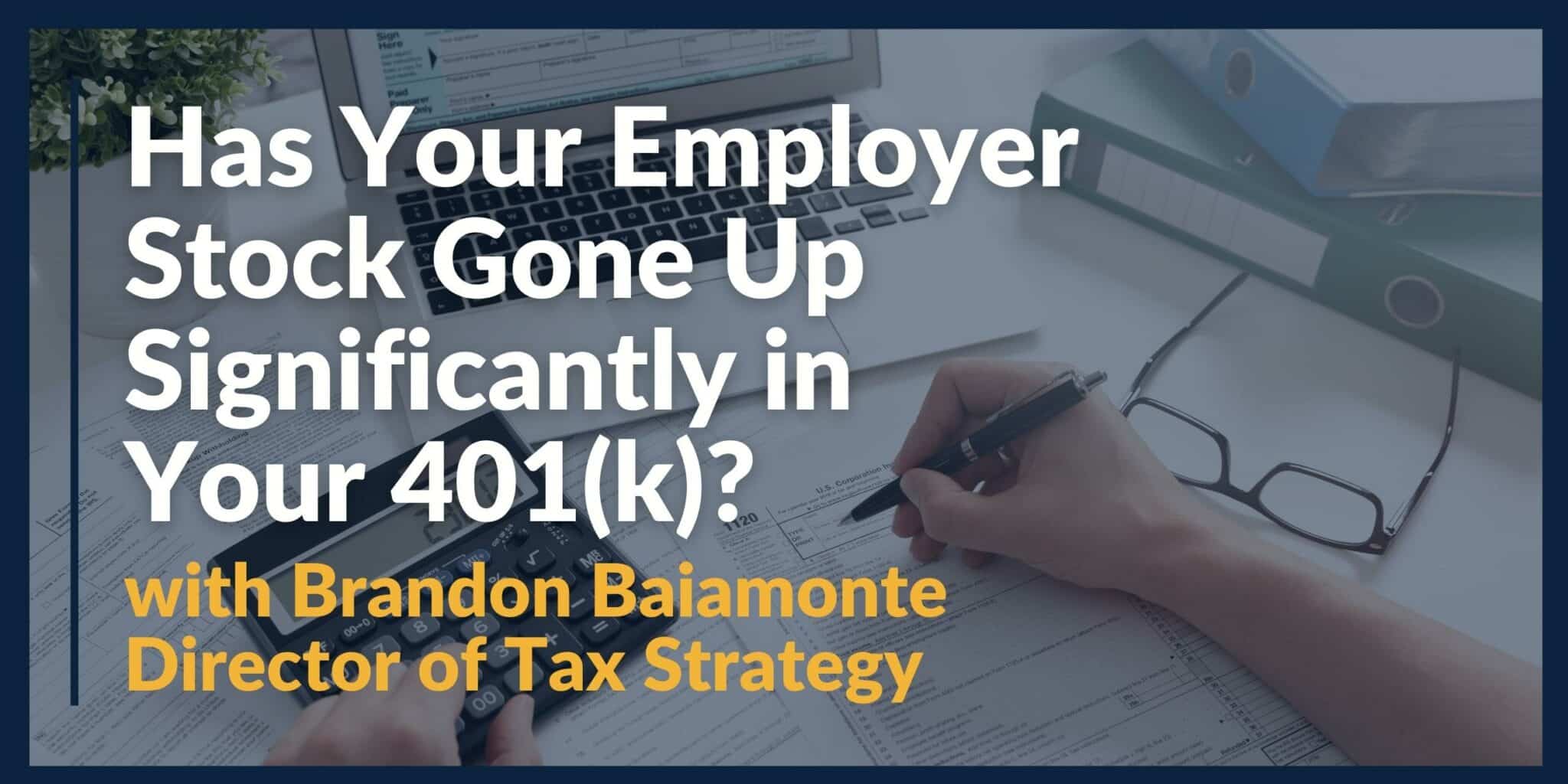
Some of us are able to purchase or receive stock in the company we work for as one of our 401(k) investment choices. The difference between what we purchased the stock for and what it is currently worth is sometimes referred to as net unrealized appreciation (NUA). When you make a taxable distribution from your 401(k) plan you generally pay taxes on the entire distribution at ordinary income tax rates.
Under certain situations with employer stock, you only pay ordinary income taxes on what you purchased the stock for (your cost basis). The NUA is then taxed at the lower long-term capital gain rate whenever you choose to sell it. Explore more topics on tax.
Below are a few conditions that must be met in order to use this strategy.
 1. In-Kind Distribution of Stock.
1. In-Kind Distribution of Stock.
You must transfer the stock directly from your 401(k) plan to a taxable brokerage account.
You can’t sell the stock in your 401(k), and then repurchase it in your taxable account. You also can’t rollover your employer stock into an IRA, and then make the decision to distribute to a taxable account later on.
 2. Lump-Sum Distribution.
2. Lump-Sum Distribution.
You must distribute your entire 401(k) balance within one tax year. You would generally need to make two different transfers. You would open up a taxable brokerage account and transfer your stock into it. You would then rollover the remainder of your 401(k) account into an IRA. You want to ensure your 401(k) balance is zero at the end of the year. Even a small balance in your 401(k) could be a problem.

Note:
You don’t need to distribute all of your company stock into a taxable account. You could transfer a portion of your employer stock into a taxable account, and then rollover the remainder (with all your other investments) into an IRA. It could make sense to only distribute your lowest basis shares to the taxable account.
3. Triggering Event.
There are four triggering events that enable you to use this strategy which are:
- Death
- Disability
- Reaching age 59 ½
- Separation from service with employer
If you meet these tests, then you are able to pay ordinary income tax rates on the amount you paid for the stock (your cost basis) and then pay long-term capital gains on the appreciation whenever you choose to sell.
 Should you use this strategy?
Should you use this strategy?
Well, it depends.
This strategy works best when the value of the stock is worth significantly more than what you paid for it. You will also want to look at what tax bracket you are in now, and compare to your likely tax bracket when you plan on making distributions from your 401(k) plan or IRA.
 This strategy might seem complicated, but can reduce your taxes significantly in some circumstances. Your client advisor at Mission Wealth is available to help coordinate with your tax advisor and is a great resource to help plan for and implement this and other strategies.
This strategy might seem complicated, but can reduce your taxes significantly in some circumstances. Your client advisor at Mission Wealth is available to help coordinate with your tax advisor and is a great resource to help plan for and implement this and other strategies.
If you have questions our financial advisors can help you explore the most cost-effective tax management solutions to help cover a number of possibilities. We have no proprietary products to sell and no quotas to fill. We simply offer independent, objective advice that serves your best interests. Contact us below.
About the Author
 Brandon Baiamonte serves as the Director of Tax Strategy at Mission Wealth. Earlier in his career, Brandon worked at Merrill Lynch as a financial advisor. This provided him with a life-long love of both the financial planning process and investing. Brandon also worked as an Internal Revenue Agent for almost 12 years, auditing hundreds of tax returns, from high net-worth individuals to businesses in a variety of different industries. Brandon spent the last six years working as both a CFO and controller for real estate development and private equity companies. Brandon earned his Bachelors of Business Administration in Accounting from Boise State University, as well as a Master of Science in Accounting from the University of Connecticut. Brandon is both a Certified Public Accountant (CPA), and a Certified Fraud Examiner (CFE).
Brandon Baiamonte serves as the Director of Tax Strategy at Mission Wealth. Earlier in his career, Brandon worked at Merrill Lynch as a financial advisor. This provided him with a life-long love of both the financial planning process and investing. Brandon also worked as an Internal Revenue Agent for almost 12 years, auditing hundreds of tax returns, from high net-worth individuals to businesses in a variety of different industries. Brandon spent the last six years working as both a CFO and controller for real estate development and private equity companies. Brandon earned his Bachelors of Business Administration in Accounting from Boise State University, as well as a Master of Science in Accounting from the University of Connecticut. Brandon is both a Certified Public Accountant (CPA), and a Certified Fraud Examiner (CFE).For discussion purposes only. This work is intended to provide general information about the tax and other laws applicable to retirement benefits. The author, his firm or anyone forwarding or reproducing this work shall have neither liability nor responsibility to any person or entity with respect to any loss or damaged caused, or alleged to be caused, directly or indirectly by the information contained in this work. This work does not represent tax, accounting, or legal advice. The individual taxpayer is advised to and should rely on their own advisors.
00410853 07/21


